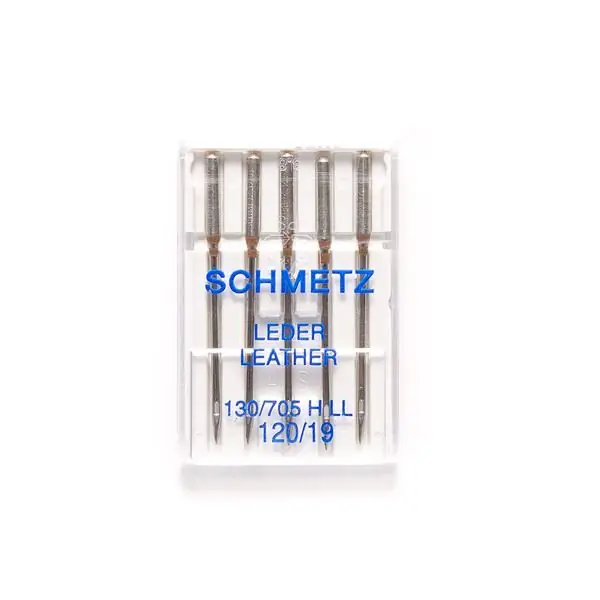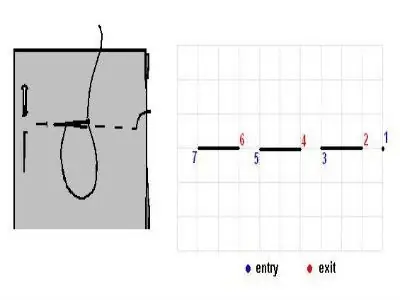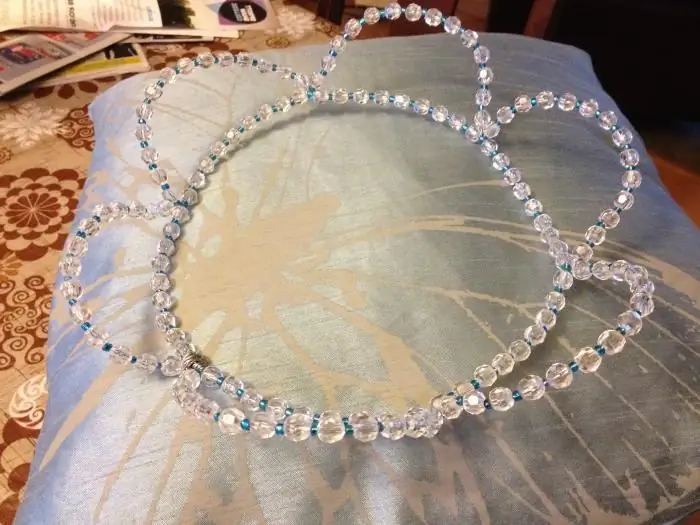
Inhaltsverzeichnis:
- Autor Sierra Becker [email protected].
- Public 2024-02-26 04:44.
- Zuletzt bearbeitet 2025-01-22 22:11.
Eine Nadel ist ein Werkzeug zum Nähen, Filzen, Sticken und für andere Handarbeiten. Das Ergebnis der Arbeit hängt weitgehend von der richtigen Wahl ab. Wenn Sie beispielsweise ein Set Quiltnadeln kaufen, die nicht gut genug gleiten, kann es schwierig sein, kleine Teile zu nähen.
So wählen Sie die richtige Nadel aus
Die Verwendung des richtigen Werkzeugs trägt dazu bei, die Qualität des Endprodukts sicherzustellen. Wie wählt man die beste Option für eine bestimmte Art von Arbeit aus? Einer der wichtigsten Parameter ist die Größe. Als allgemeine Regel gilt, den kleinsten Nadeldurchmesser zu verwenden.
Je größer das Werkzeug, desto größer das Loch, das es macht. Und während einige Stoffe nach Abschluss des Projekts in ihre ursprüngliche Form zurückkehren können, können andere, wie Leder, dies nicht. Eine Nadel ist im Wesentlichen ein kleines Messer, das durch die Haut schneidet, daher ist es wichtig, dass es stark und scharf ist.

Mehrzwecknadeln
Es gibt Universalwerkzeuge, deren Augengröße etwas kleiner ist als die von Standardwerkzeugen,für bestimmte Arbeiten konzipiert. Trotzdem können Sie nicht dieselbe Nadel für verschiedene Projekte verwenden.
Mehrzwecknadeln können beim Sticken oder Nähen verwendet werden, aber wenn Sie ein Qualitätsprodukt herstellen möchten, ist es wichtig, ein professionelles Werkzeug zu verwenden. Zum Beispiel kann eine gewöhnliche Stickerei mit einer Nadel, die für ein Band gedacht ist, die Leinwand ruinieren und das Design stören.

Hauptarten von handgefertigten Nadeln
Handnadeln werden je nach Verwendungszweck in verschiedene Typen eingeteilt:
- Scharfe Nadeln sind für das Nähen von Hand konzipiert. Sie sind normalerweise spitz, mit rundem Auge und mittlerer Länge.
- Applikationsnadel ist eine vielseitige Nadel, die zum Nähen, Applizieren und Patchwork verwendet werden kann.
- Sticknadel - mit einem stumpfen Ende und einem vergrößerten Öhr, das das Einfädeln eines dicken Fadens oder mehrerer Fäden erleichtert.
- Quiltnadel - kurz, mit einem kleinen runden Öhr. Es wird zum Erstellen feiner Nähte auf schweren Stoffen, beim Nähen von Kleidung, Decken und ähnlichen Arbeiten verwendet.
- Perlennadel - sehr fein, mit einem schmalen Öhr, damit sie zusammen mit dem Faden durch die Mitte der Perle oder Perle geführt werden kann.
- Dubbingnadeln sind lange, dicke Nadeln, die beim Fliegenbinden verwendet werden.
- Gobelinnadeln sind Werkzeuge mit einem großen Öhr, das es ihnen ermöglicht, mehr Garngewicht zu tragen als andere Nadeln. Sie haben eine stumpfe Spitze, die normalerweise in einem leichten Winkel zum Rest der Nadel gebogen ist. Dank anDaher kann die Nadel locker gewebte Fäden des Stoffes durchdringen, ohne ihn zu zerreißen.
- Chenillenadeln ähneln Gobelinnadeln, aber mit großen, langen Öhren und einer sehr scharfen Spitze, die durch eng gewebte Stofffäden schneiden kann. Wird beim Sticken mit Bändern verwendet.
- Stopfnadeln (manchmal auch Finishing-Nadeln genannt). Sie haben eine stumpfe Spitze und ein großes Auge, wodurch sie einem Wandteppich ähneln, aber größer sind.
- Hautnadeln sind ein keilförmiges Instrument, das entwickelt wurde, um die Haut zu durchstechen, ohne zu reißen. Wird häufig für Materialien wie Vinyl und Kunststoff verwendet.
- Segelnadeln ähneln Ledernadeln, aber sie haben eine dreieckige Form und sind zum Nähen von dickem Segeltuch oder Leder gedacht.
- Klöppelnadeln haben über ihre gesamte Länge eine gleichmäßige Dicke, auch um das Öhr herum, damit der Faden leichter durch die beim Weben verwendeten Doppelstiche gezogen werden kann.
- Polsternadeln sind schwer und lang. Sie können gerade oder gebogen sein. Dieses Werkzeug wird zum Nähen von dicken Stoffen und Polstern verwendet.

Ordnen Sie in einer separaten Kategorie Nadeln zum Filzen von Wolle zu. Ihre Form unterscheidet sich von den beim Handnähen verwendeten Werkzeugen durch das Fehlen einer Öse.
Klassifizierung von Filznadeln
Filznadeln werden verwendet, um das Material zu verdichten. Wollfasern reiben aneinander und rasten ein, um ein dichteres Material namens Filz zu erzeugen.
Davon gibt es mehrere VariantenNadel:
- dreieckig;
- verdrehtes Dreieck;
- umgekehrtes Dreieck;
- sternförmig;
- verdrehter Stern;
- Krone.

Sie alle unterscheiden sich in Zweck und Form:
- Die Dreikantnadel ist ein dreiseitiges Werkzeug mit Kerben über die gesamte Länge. Es wird zum groben Filzen verwendet.
- Die umgekehrte Nadel zupft die Fasern heraus, sodass Sie Tierspielzeug mit Fell versehen können, das wie echtes Haar aussieht.
- "Asterisk" hat vier Seiten. Es eignet sich für Feinarbeiten und Formen von Kleinteilen.
- Gedrehte Nadeln beschleunigen den Filzvorgang dank mehr Kerben an den Enden.
Alle Filzwerkzeuge sind sehr scharf und können die Hände schwer verletzen, wenn keine Fingerhüte verwendet werden.
Empfohlen:
Wie man eine Nadel in eine Nähmaschine einführt: Gebrauchsanweisung, Betrieb und Reparatur, Tipps

Nadelgerät. Arten von Nähmaschinen. Anleitung zum Einsetzen einer Nadel in eine Nähmaschine. Wie man eine Zwillingsnadel in eine Nähmaschine einführt. Tipps für den Betrieb. Falsche Nadelinstallation: die Ursache des Ausfalls
Auswahl von Nadeln für Nähmaschinen für verschiedene Zwecke. Wie führt man eine Nadel in eine Nähmaschine ein?

Grundlegende Voraussetzung für das einwandfreie Funktionieren der Nähmaschine - für hochwertige Nähte und perfekt genähte Sachen - ist der richtige Einbau der Nadel. Viele Nadelfrauen fragen sich, wie man eine Nadel richtig in eine alte Nähmaschine ("Singer" oder "Seagull") einführt, wie man das bei einer neuen Maschine macht. Um diese Frage zu beantworten, müssen Sie das Prinzip der Installation einer Nadel verstehen
Endspiel ist… Beschreibung und Klassifizierung der Endspiele von Schachpartien

Der Artikel enthüllt die Bedeutung des Schachbegriffs "Endspiel", gibt seine Unterscheidungsmerkmale und Einordnung wieder
Stiche beim Sticken "Nadel nach vorne". Stickerei "vorwärts mit einer Nadel" mit Diagrammen und Fotos

Einfach und vielseitig sind die Nähte, bei denen die Bewegung der Nadel nach vorne gerichtet ist. Sie können für Handarbeiten beim Nähen von Kleidung oder Stofftieren, beim Dekorieren fertiger Produkte oder als Hilfstechniken verwendet werden
Eine Perlenkrone ist eine exquisite Dekoration für eine Prinzessin

Jede Frau hat mindestens einmal in ihrem Leben von einer Krone geträumt. Besonders gerne würde ich diese Dekoration für kleine Mädchen anprobieren, um die alle ihre Freundinnen beneiden. Wie Sie es selber machen, lesen Sie hier
